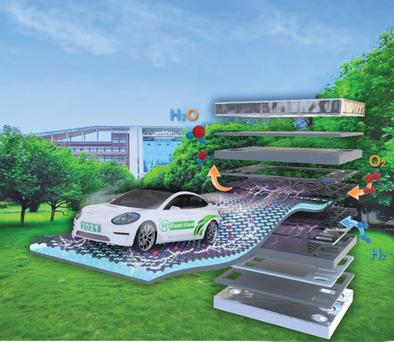当前位置:
X-MOL 学术
›
Adv. Energy Mater.
›
论文详情
Our official English website, www.x-mol.net, welcomes your
feedback! (Note: you will need to create a separate account there.)
Advanced Atomically Dispersed Metal–Nitrogen–Carbon Catalysts Toward Cathodic Oxygen Reduction in PEM Fuel Cells
Advanced Energy Materials ( IF 24.4 ) Pub Date : 2021-08-26 , DOI: 10.1002/aenm.202101222 Yijie Deng 1 , Junming Luo 2 , Bin Chi 3 , Haibo Tang 4 , Jing Li 2 , Xiaochang Qiao 5 , Yijun Shen 2 , Yingjie Yang 2 , Chunman Jia 2 , Peng Rao 2 , Shijun Liao 3 , Xinlong Tian 2
Advanced Energy Materials ( IF 24.4 ) Pub Date : 2021-08-26 , DOI: 10.1002/aenm.202101222 Yijie Deng 1 , Junming Luo 2 , Bin Chi 3 , Haibo Tang 4 , Jing Li 2 , Xiaochang Qiao 5 , Yijun Shen 2 , Yingjie Yang 2 , Chunman Jia 2 , Peng Rao 2 , Shijun Liao 3 , Xinlong Tian 2
Affiliation

|
Proton exchange membrane fuel cells (PEMFCs) are a highly efficient hydrogen energy conversion technology, which shows great potential in mitigating carbon emissions and the energy crisis. Currently, to accelerate the kinetics of the oxygen reduction reaction (ORR) required for PEMFCs, extensive utilization of expensive and rare platinum-based catalysts are required at the cathodic side, impeding their large-scale commercialization. In response to this issue, atomically dispersed metal–nitrogen–carbon (M–N–C) catalysts with cost-effectiveness, encouraging activity, and unique advantages (e.g., homogeneous activity sites, high atom efficiency, and intrinsic activity) have been widely investigated. Considerable progress in this domain has been witnessed in the past decade. Herein, a comprehensive summary of recent development in atomically dispersed M–N–C catalysts for the ORR under acidic conditions and of their application in the membrane electrode assembly (MEA) of PEM fuel cells, are presented. The ORR mechanisms, composition, and operating principles of PEMFCs are introduced. Thereafter, atomically dispersed M–N–C catalysts towards improved acidic ORR and MEA performance is summarized in detail, and improvement strategies for MEA performance and stability are systematically analyzed. Finally, remaining challenges and significant research directions for design and development of high-performance atomically dispersed M–N–C catalysts and MEA are discussed.
中文翻译:

先进的原子分散金属-氮-碳催化剂在 PEM 燃料电池中实现阴极氧还原
质子交换膜燃料电池(PEMFCs)是一种高效的氢能转换技术,在缓解碳排放和能源危机方面显示出巨大潜力。目前,为了加速 PEMFC 所需的氧还原反应 (ORR) 的动力学,需要在阴极广泛使用昂贵且稀有的铂基催化剂,阻碍了它们的大规模商业化。针对这个问题,原子分散的金属-氮-碳(M-N-C)催化剂具有成本效益、令人鼓舞的活性和独特的优势(例如,均质的活性位点、高原子效率和内在活性)已被广泛应用。调查。在过去十年中,该领域取得了相当大的进展。在此处,对酸性条件下用于 ORR 的原子分散 M-N-C 催化剂的最新发展及其在 PEM 燃料电池的膜电极组件 (MEA) 中的应用进行了全面总结。介绍了 PEMFCs 的 ORR 机制、组成和工作原理。此后,详细总结了原子分散的 M-N-C 催化剂以提高酸性 ORR 和 MEA 性能,并系统地分析了 MEA 性能和稳定性的改进策略。最后,讨论了高性能原子分散 M-N-C 催化剂和 MEA 的设计和开发的剩余挑战和重要研究方向。介绍了 PEMFCs 的 ORR 机制、组成和工作原理。此后,详细总结了原子分散的 M-N-C 催化剂以提高酸性 ORR 和 MEA 性能,并系统地分析了 MEA 性能和稳定性的改进策略。最后,讨论了高性能原子分散 M-N-C 催化剂和 MEA 的设计和开发的剩余挑战和重要研究方向。介绍了 PEMFCs 的 ORR 机制、组成和工作原理。此后,详细总结了原子分散的 M-N-C 催化剂以提高酸性 ORR 和 MEA 性能,并系统地分析了 MEA 性能和稳定性的改进策略。最后,讨论了高性能原子分散 M-N-C 催化剂和 MEA 的设计和开发的剩余挑战和重要研究方向。
更新日期:2021-10-06
中文翻译:

先进的原子分散金属-氮-碳催化剂在 PEM 燃料电池中实现阴极氧还原
质子交换膜燃料电池(PEMFCs)是一种高效的氢能转换技术,在缓解碳排放和能源危机方面显示出巨大潜力。目前,为了加速 PEMFC 所需的氧还原反应 (ORR) 的动力学,需要在阴极广泛使用昂贵且稀有的铂基催化剂,阻碍了它们的大规模商业化。针对这个问题,原子分散的金属-氮-碳(M-N-C)催化剂具有成本效益、令人鼓舞的活性和独特的优势(例如,均质的活性位点、高原子效率和内在活性)已被广泛应用。调查。在过去十年中,该领域取得了相当大的进展。在此处,对酸性条件下用于 ORR 的原子分散 M-N-C 催化剂的最新发展及其在 PEM 燃料电池的膜电极组件 (MEA) 中的应用进行了全面总结。介绍了 PEMFCs 的 ORR 机制、组成和工作原理。此后,详细总结了原子分散的 M-N-C 催化剂以提高酸性 ORR 和 MEA 性能,并系统地分析了 MEA 性能和稳定性的改进策略。最后,讨论了高性能原子分散 M-N-C 催化剂和 MEA 的设计和开发的剩余挑战和重要研究方向。介绍了 PEMFCs 的 ORR 机制、组成和工作原理。此后,详细总结了原子分散的 M-N-C 催化剂以提高酸性 ORR 和 MEA 性能,并系统地分析了 MEA 性能和稳定性的改进策略。最后,讨论了高性能原子分散 M-N-C 催化剂和 MEA 的设计和开发的剩余挑战和重要研究方向。介绍了 PEMFCs 的 ORR 机制、组成和工作原理。此后,详细总结了原子分散的 M-N-C 催化剂以提高酸性 ORR 和 MEA 性能,并系统地分析了 MEA 性能和稳定性的改进策略。最后,讨论了高性能原子分散 M-N-C 催化剂和 MEA 的设计和开发的剩余挑战和重要研究方向。











































 京公网安备 11010802027423号
京公网安备 11010802027423号